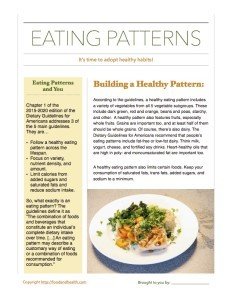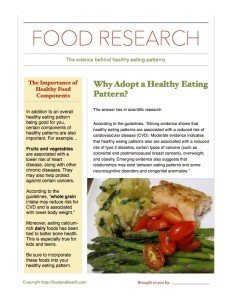The 2015 Dietary Guidelines: Eating Patterns
Have you read the latest edition of the Dietary Guidelines for Americans?Over the next few weeks, we'll be exploring each aspect of the guidelines and discussing all the key information. Today, we'll begin with a guide to the first chapter.Chapter 1: Key Elements of Healthy Eating PatternsThis chapter addresses 3 of the 5 dietary guidelines for Americans. They include...
- Follow a healthy eating pattern across the lifespan.
- Focus on variety, nutrient density, and amount.
- Limit calories from added sugars and saturated fats and reduce sodium intake.
So, what exactly is an eating pattern? The guidelines define it as "The combination of foods and beverages that constitute an individual’s complete dietary intake over time. Often referred to as a 'dietary pattern,' an eating pattern may describe a customary way of eating or a combination of foods recommended for consumption."Furthermore, the 2015-2020 Dietary Guidelines for Americans insist that an eating pattern represents the totality of all foods and beverages consumed and that those foods and beverages should be the primary vehicles for meeting nutrient needs. They maintain, "Foods in nutrient-dense forms contain essential vitamins and minerals and also dietary fiber and other naturally occurring substances that may have positive health effects." It's also worth noting that healthy eating patterns are adaptable. Each person can take a different path to healthy eating -- there's far more than one way to reach these dietary goals.Now, what components of a healthy eating pattern should people be exploring?According to the guidelines, a healthy eating pattern includes a variety of vegetables from all 5 vegetable subgroups. These subgroups include dark green, red and orange, legumes – also known as beans and peas – starchy, and other. A healthy eating pattern also includes fruits, especially whole fruits. Grains are important too, and at least half of them should be whole grains. Of course, there’s also dairy. The Dietary Guidelines for Americans recommend that people’s eating patterns include fat-free or low-fat dairy. Think milk, yogurt, cheese, and fortified soy drinks. Heart-healthy oils that are high in poly- and monounsaturated fat are important too.A healthy eating pattern also limits certain foods. Keep your consumption of saturated fats, trans fats, added sugars, and sodium to a minimum. To help you do this, the Dietary Guidelines for Americans has established quantitative limit recommendations, which include...
- Added sugars should make up less than 10% of your total calories per day.
- Saturated fats should make up less than 10% of your total calories per day.
- Sodium should be less consumed in quantities of less than 2,300 mg per day.
- If alcohol is consumed, it should be done only by adults of legal drinking age. It should also be consumed in moderation -- up to one drink per day for women and up to two drinks per day for men.
For more information about the added sugar limits, don't miss the latest post from Beth Rosen, MS, RD, CDN: Dietary Guidelines for Americans 2015-2020: The News About Sugar.Want to share this information with your clients? Here's a brand-new (and free!) PDF handout that you can distribute however you want! Now, after reading all these recommendations, I had to ask -- what is the scientific basis for these claims? Luckily, the guidelines include lots of information about the science behind their recommendations for healthy eating patterns. I've gone through each point in the member-exclusive post The 2015 Dietary Guidelines: The Science of Healthy Eating Patterns. It even comes with a free PDF handout!
Now, after reading all these recommendations, I had to ask -- what is the scientific basis for these claims? Luckily, the guidelines include lots of information about the science behind their recommendations for healthy eating patterns. I've gone through each point in the member-exclusive post The 2015 Dietary Guidelines: The Science of Healthy Eating Patterns. It even comes with a free PDF handout! If you'd like to read that post but aren't a member yet, check out the ways that you can access this article.Plus, there are lots of great resources available in the Nutrition Education Store!
If you'd like to read that post but aren't a member yet, check out the ways that you can access this article.Plus, there are lots of great resources available in the Nutrition Education Store!
 And here's a link to all of the newest materials!
And here's a link to all of the newest materials!